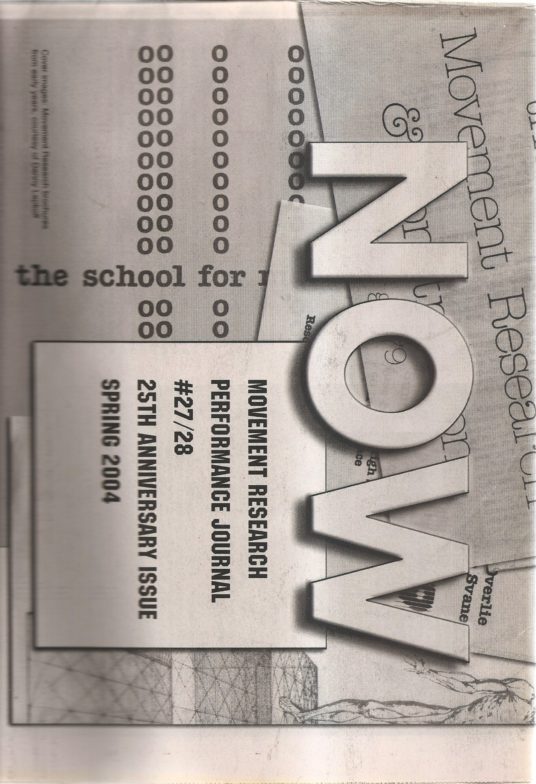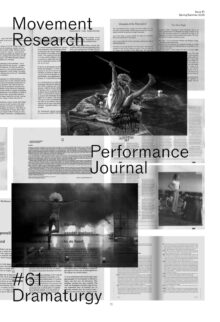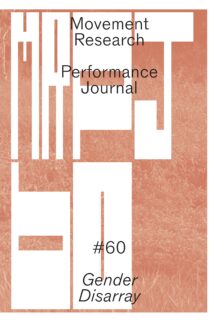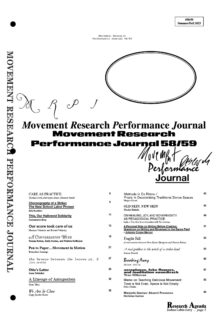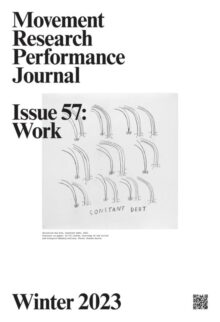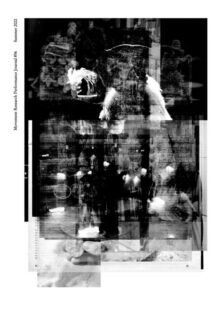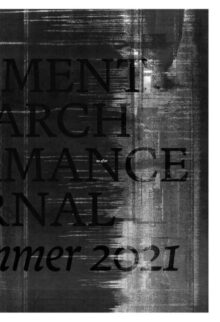This issue is OUT OF PRINT.
From the Editor
I am humbled by the writing here. I can hardly believe that I’ve been lucky enough to be a part of this process, and that is not a hyperbole. People allowed me in to deep and wonderful parts of themselves, and showed to me the rough diamonds of their words. From Susan Foster’s meditation on small spaces to koosil-ja’s rock and roll memoir to Mayra Wethers’ brave statistical study, from Daria Faïn’s treatise on the impossible to Kenneth King’s prophesy of the Information Age to Jennifer Monson’s visions for the future, to Juliette Mapp’s refection on the meaning of dance class and Cathy Weis’ rollicking ride; from Jonah Bokaer’s classical polemic, to Jill Johnson’s wry rumination’s, to Diane Vivona’s research treatise on moving.
I have to admit that the names above are selected at random. Everything here makes me think and breathe differently. These voices create air in the room, stir up the flame and increase the blood flow the brain. They are scientists experimenting with words and ideas in the realm of the non-verbal, and fluidly working their way through history to make a loop de loop between past and present.
Then there’s the oral histories. Almost without knowing it, we have created here an archive of living voices that spans the entire 25 year history of Movement Research, and beyond. Most importantly, many of these are the voices of the administrators who are often also artists) that piece together this puzzle of keeping an organization alive and keeping a field vital and growing; valuable voices that are inextricably bound to the history of an art form. In the same contextualizing spirit we decided to include a timeline that provides a running log of the times that surrounded the community of artists as they were making their art to give some sense of how the artistic discoveries connected to a larger world.
It is entirely appropriate that editing this journal should so closely mimic my creative process when making performance. Movement Research gave me the tools to figure out what the hell I was doing, and then do it. I muddled around passionately and dipped into every well I could find, all along sure that nobody understood meat all. Now looking back I understand that understanding wasn’t what I needed. I needed tools and space and encouragement, and that came to me, first and foremost, from Movement Research. In conversation with John Jasperse recently, we talked about that thing in dance that draws us to do it even though— well, you can fill in the blanks. I myself keep running far afield from movement investigation as such, but I keep rubber-banding back to the intelligent body, the physical existence, the corporeal delight of moving. This is the legacy of my Movement Research.
—Clarinda Mac Low, Guest Editor
Thanks without end to Arturo for his Herculean labors in the service of truth, his sharp transcribing ears and his absolutely good-natured zeal for hard work. Thanks muchly to Eleanor D. for her wit, thoughtfulness, willingness, and enthusiasm. Deep gratitude to Carla. Anne. Amanda and the staff of Movement Research for their patient with my crazy schemes, and their excellent suggestions. Thanks AGAIN to Paz for being game and terribly talented. Many thanks to Eric Nielsen and the Gallup Poll Organization for their generosity. Thank you to Anja H. for her patience and thoroughness, to Eleanor Bauer for last-minute editing, to Danny Lepkoff for entrusting us with his orignal brochures, and to Paul Vidich and Linda Sue Stein for their gorgeous house. And thank you thank you thank you to everybody who talked and wrote and discussed and shared. Your voices are precious and I am privileged to have
engaged with you all.
Clarinda Mac Low lives, writes and makes situations in New York City. Sometimes elsewhere, too, but not lately: In July 2004 watch out for a TRYST in the Financial District and a Salvaged nest in the Queens Botanical Garden.
